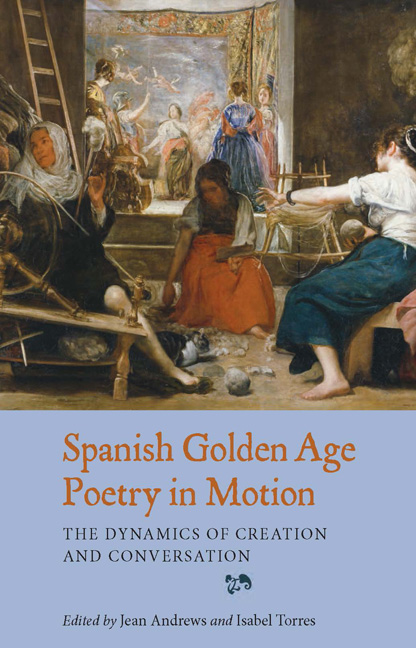Book contents
- Frontmatter
- Contents
- Contributors
- Acknowledgements
- Introduction
- 1 La poesía mutante del Siglo de Oro
- Part 1 Poetry in Creation
- 2 Moving in …Garcilaso de la Vega's ‘Dulces prendas por mi mal halladas’
- 3 The Movement of Thought and Feeling in the ‘Ode to Juan de Grial’
- 4 Metaphors of Movement in Two Poems of Fray Luis de León
- 5 El tiempo medido en versos: Camila Lucinda en las Rimas (1609) de Lope de Vega
- 6 Upwards to Helicon: Lope de Vega, the Laurel de Apolo, and Acts of Judgement
- 7 ‘Dulce es refugio’: El peregrino de Góngora se detiene
- 8 The Staging of Góngora's Three Funereal Sonnets for Margarita de Austria Estiria
- 9 Jealousy in María de Zayas's Intercalated Poetry: Lyric Illness and Narrative Cure
- 10 Hacia otra lectura del petrarquismo en Sor Juana Inés de la Cruz
- Part 2 Poetry in Conversation
- 11 El conde de Salinas y Leonor Pimentel: cuando se juntan el amor y la poesía
- 12 Poesía popular en movimiento: los jeroglíficos ‘muy propios al intento y muy de su profesión’ en las celebraciones de la Valencia barroca
- 13 Responding to Góngora: María Rosal and the Clori Poems
- 14 Traveling in Place: Baroque Lyric Transports in Translation, or Flames that Bridge the Stream
- Works Cited
- Index
5 - El tiempo medido en versos: Camila Lucinda en las Rimas (1609) de Lope de Vega
Published online by Cambridge University Press: 05 November 2014
- Frontmatter
- Contents
- Contributors
- Acknowledgements
- Introduction
- 1 La poesía mutante del Siglo de Oro
- Part 1 Poetry in Creation
- 2 Moving in …Garcilaso de la Vega's ‘Dulces prendas por mi mal halladas’
- 3 The Movement of Thought and Feeling in the ‘Ode to Juan de Grial’
- 4 Metaphors of Movement in Two Poems of Fray Luis de León
- 5 El tiempo medido en versos: Camila Lucinda en las Rimas (1609) de Lope de Vega
- 6 Upwards to Helicon: Lope de Vega, the Laurel de Apolo, and Acts of Judgement
- 7 ‘Dulce es refugio’: El peregrino de Góngora se detiene
- 8 The Staging of Góngora's Three Funereal Sonnets for Margarita de Austria Estiria
- 9 Jealousy in María de Zayas's Intercalated Poetry: Lyric Illness and Narrative Cure
- 10 Hacia otra lectura del petrarquismo en Sor Juana Inés de la Cruz
- Part 2 Poetry in Conversation
- 11 El conde de Salinas y Leonor Pimentel: cuando se juntan el amor y la poesía
- 12 Poesía popular en movimiento: los jeroglíficos ‘muy propios al intento y muy de su profesión’ en las celebraciones de la Valencia barroca
- 13 Responding to Góngora: María Rosal and the Clori Poems
- 14 Traveling in Place: Baroque Lyric Transports in Translation, or Flames that Bridge the Stream
- Works Cited
- Index
Summary
En 1609 se publicó la versión aumentada de las Rimas de Lope de Vega, la edición conocida ahora sobre todo por la presencia del Arte nuevo de hacer comedias. Sin embargo, la colección termina con un soneto en que imaginativamente Lope le da la voz y la palabra a Camila Lucinda, la musa principal de las Rimas, en un mise en scène en que transforma a ella en Eurídice y a sí mismo en ‘español Orfeo’, archimúsico y archipoeta nombrado así por su musa. En aquella época se conocía a Orfeo también como la figura simbólica del mago que utiliza la música o la poesía como un agente de cambio, un medio para encauzar el amor hacia algo o alguien para realizar una transformación o una serie de cambios. Así que en el primer terceto del poema la voz del poeta órfico exclama: ‘¡Oh clara luz de amor que el hielo inflama!,/ su curso el tiempo en estos versos mida;/ sirvan de paralelos a su llama.’ El mago invoca el recuerdo de la luz brillante del amor muerto o perdido como la fuente de la inspiración poética, y a lo largo de las Rimas explora el paralelismo entre la luz, Lucinda y las imágenes de luz. En estos versos lo hace para sugerir que la memoria de ese amor, transformada en poesía, es suficiente para derretir el hielo del olvido o de la muerte para recuperar al amor, y a la Lucinda suya, viva y enamorada de él, de nuevo.
- Type
- Chapter
- Information
- Spanish Golden Age Poetry in MotionThe Dynamics of Creation and Conversation, pp. 87 - 100Publisher: Boydell & BrewerPrint publication year: 2014



